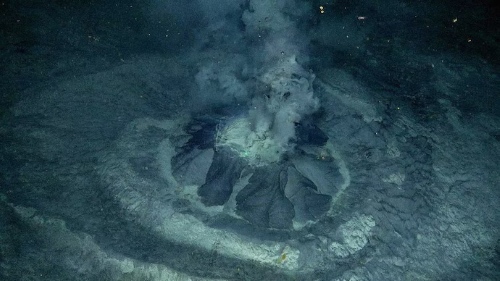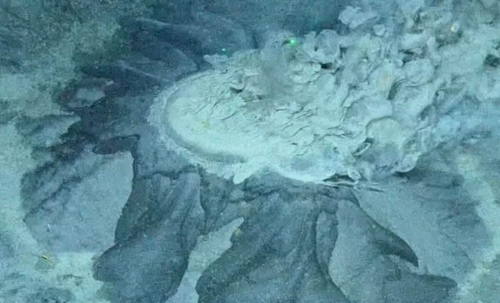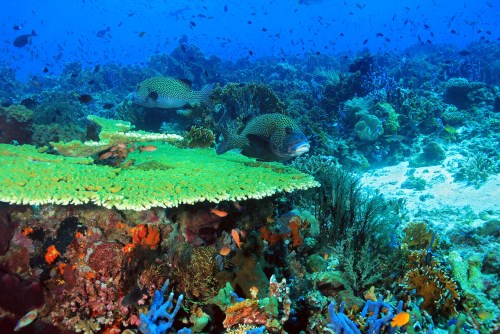Deep beneath the icy waters of the Barents Sea, scientists have uncovered an extraordinary geological phenomenon—a 7,000-year-old mud volcano teeming with marine life. Named the Borealis Mud Volcano, this ancient formation, located 400 meters below the surface, challenges our understanding of deep-sea ecosystems and climate interactions.
Who has Discovered & what is the Location?
- Discovered by: UiT – The Arctic University of Norway (2023)
- Location: Barents Sea, Norwegian waters
- Depth: 400 meters
- Expedition Partners: Ocean Census, REV Ocean, The Nippon Foundation-Nekton Ocean Census
- Exploration Technology: Remotely Operated Vehicle (ROV)
.jpg)
What are the Key Characteristics of the Borealis Mud Volcano?
Key Characteristics:
| Aspect | Details |
| Geographical Location | Barents Sea, Arctic Ocean |
| Depth | 400 meters below sea level |
| Estimated Age | Approximately 7,000 years old |
| Temperature Influence | Raises local water temperature to 11.5°C (compared to the ambient 4°C) |
| Geological Activity | Expels methane-rich fluids, contributing to unique seabed formations |
| Ecosystem Impact | Provides habitat for deep-sea life, including sponges, anemones, and fish species |

Source: revocean.org
Why Is This Discovery Important?
1. Geological Anomaly
Unlike conventional volcanoes that erupt with lava, mud volcanoes like Borealis release methane-rich fluids and sediments. These processes shape the surrounding seabed, forming a unique deep-sea environment.
2. Biodiversity Hotspot
Contrary to expectations, this deep-sea volcano is not barren but serves as a sanctuary for marine species. Scientists observed various organisms thriving on the carbonate crusts formed over thousands of years, including:
- Anemones, serpulids, demosponges, and sparse octocoral colonies – found clinging to the hard carbonate formations.
- Fish species – such as saithe, cod, redfish, four-bearded rockling, and spotted wolffish, which rely on the volcano's shelter and feeding grounds.
3. Climate and Ocean Chemistry Implications
The Borealis Mud Volcano plays a significant role in:
- Methane Sequestration: Microbial communities in the mud volcano absorb methane, reducing its release into the atmosphere—a key factor in climate regulation.
- Deep-Sea Temperature Regulation: The localized warming effect creates a microhabitat that supports marine life in an otherwise frigid deep-sea environment.
Unveiling a Unique Geological Structure
Unlike conventional volcanoes that erupt with molten lava, mud volcanoes eject a combination of fluidized sediments and gases, particularly methane. The Borealis Mud Volcano features carbonate crust formations and an active crater, offering a habitat for deep-sea organisms.
Discovery and Research Expedition
- The UiT – The Arctic University of Norway, in partnership with REV Ocean and Ocean Census, identified this feature in 2023.
- Researchers deployed remotely operated vehicles (ROVs) to capture high-resolution imagery and document the ecosystem surrounding the volcano.
- Initial findings revealed that this geological structure supports an array of marine species previously undocumented in this region.

Source: dailygalaxy
A Thriving Deep-Sea Ecosystem
Despite its extreme conditions, the Borealis Mud Volcano fosters a resilient ecosystem:
- Methane-dependent microbial life plays a crucial role in carbon cycling.
- Sessile organisms such as sponges, anemones, and octocorals, attach to the rocky carbonate crusts.
- Commercially significant fish species like cod, saithe, redfish, and spotted wolffish, use volcanic structures for shelter and feeding.

Source: cfact.org
How It Compares to Hydrothermal Vents
| Feature | Mud Volcano (Borealis) | Hydrothermal Vent |
| Heat Source | Methane gas emissions | Magma-driven activity |
| Ecosystem Stability | Supports long-term habitats | Often unstable |
| Biodiversity | Rich but still under study | Well-documented and diverse |
| Temperature Range | Raises local water to 11.5°C | Can exceed 350°C |
What is ongoing Scientific research to Explore Borealis Mud Volcano?
Ongoing scientific research to Explore Borealis Mud Volcano is:
- Ongoing Missions: Scientists plan to continue exploring the Arctic seafloor with advanced underwater vehicles to map similar formations.
- Unanswered Questions: Researchers are investigating how long the mud volcano has been active and whether other hidden ecosystems exist beneath the Arctic seabed.
- Comparative Studies: Understanding Borealis may provide insights into extraterrestrial ocean environments, such as the subsurface seas of Jupiter’s moon Europa and Saturn’s moon Enceladus.
What will be the Future Research Prospects on this mission?
Future studies aim to:
- Utilize advanced ROV technology to conduct detailed mapping of the region.
- Investigate interactions between marine species and their adaptations to methane-rich environments.
- Identify other potential deep-sea volcanic formations in the Arctic, expanding knowledge on subsea geological processes.
Conclusion
The discovery of the Borealis Mud Volcano redefines our understanding of Arctic marine ecosystems and deep-sea geology. This unique structure, teeming with marine life, offers a new frontier for scientific research—shedding light on deep-sea biodiversity, methane cycling, and potential parallels to extraterrestrial environments. As investigations continue, the insights gained from this Arctic marvel could shape future oceanographic and planetary exploration studies.
Comments
All Comments (0)
Join the conversation